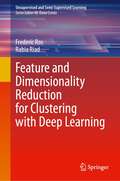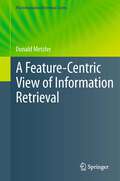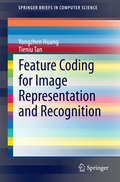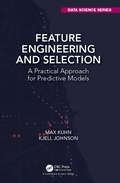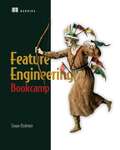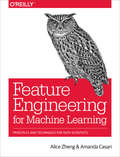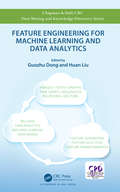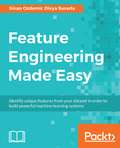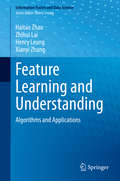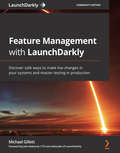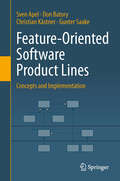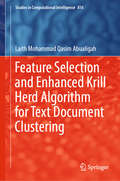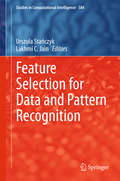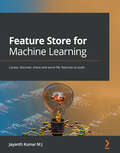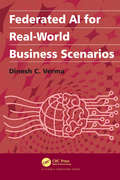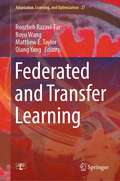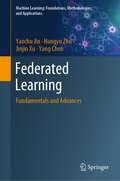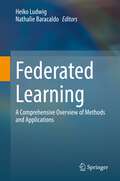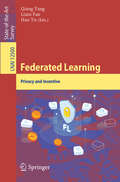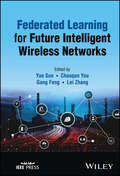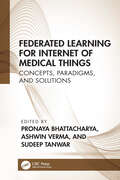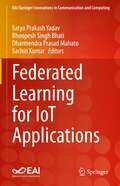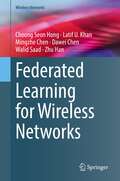- Table View
- List View
Feature and Dimensionality Reduction for Clustering with Deep Learning (Unsupervised and Semi-Supervised Learning)
by Frederic Ros Rabia RiadThis book presents an overview of recent methods of feature selection and dimensionality reduction that are based on Deep Neural Networks (DNNs) for a clustering perspective, with particular attention to the knowledge discovery question. The authors first present a synthesis of the major recent influencing techniques and "tricks" participating in recent advances in deep clustering, as well as a recall of the main deep learning architectures. Secondly, the book highlights the most popular works by “family” to provide a more suitable starting point from which to develop a full understanding of the domain. Overall, the book proposes a comprehensive up-to-date review of deep feature selection and deep clustering methods with particular attention to the knowledge discovery question and under a multi-criteria analysis. The book can be very helpful for young researchers, non-experts, and R&D AI engineers.
A Feature-Centric View of Information Retrieval (The Information Retrieval Series #27)
by Donald MetzlerCommercial Web search engines such as Google, Yahoo, and Bing are used every day by millions of people across the globe. With their ever-growing refinement and usage, it has become increasingly difficult for academic researchers to keep up with the collection sizes and other critical research issues related to Web search, which has created a divide between the information retrieval research being done within academia and industry. Such large collections pose a new set of challenges for information retrieval researchers. In this work, Metzler describes highly effective information retrieval models for both smaller, classical data sets, and larger Web collections. In a shift away from heuristic, hand-tuned ranking functions and complex probabilistic models, he presents feature-based retrieval models. The Markov random field model he details goes beyond the traditional yet ill-suited bag of words assumption in two ways. First, the model can easily exploit various types of dependencies that exist between query terms, eliminating the term independence assumption that often accompanies bag of words models. Second, arbitrary textual or non-textual features can be used within the model. As he shows, combining term dependencies and arbitrary features results in a very robust, powerful retrieval model. In addition, he describes several extensions, such as an automatic feature selection algorithm and a query expansion framework. The resulting model and extensions provide a flexible framework for highly effective retrieval across a wide range of tasks and data sets. A Feature-Centric View of Information Retrieval provides graduate students, as well as academic and industrial researchers in the fields of information retrieval and Web search with a modern perspective on information retrieval modeling and Web searches.
Feature Coding for Image Representation and Recognition
by Yongzhen Huang Tieniu TanThis brief presents a comprehensive introduction to feature coding, which serves as a key module for the typical object recognition pipeline. The text offers a rich blend of theory and practice while reflects the recent developments on feature coding, covering the following five aspects: (1) Review the state-of-the-art, analyzing the motivations and mathematical representations of various feature coding methods; (2) Explore how various feature coding algorithms evolve along years; (3) Summarize the main characteristics of typical feature coding algorithms and categorize them accordingly; (4) Discuss the applications of feature coding in different visual tasks, analyze the influence of some key factors in feature coding with intensive experimental studies; (5) Provide the suggestions of how to apply different feature coding methods and forecast the potential directions for future work on the topic. It is suitable for students, researchers, practitioners interested in object recognition.
Feature Engineering and Selection: A Practical Approach for Predictive Models (Chapman & Hall/CRC Data Science Series)
by Max Kuhn Kjell JohnsonThe process of developing predictive models includes many stages. Most resources focus on the modeling algorithms but neglect other critical aspects of the modeling process. This book describes techniques for finding the best representations of predictors for modeling and for nding the best subset of predictors for improving model performance. A variety of example data sets are used to illustrate the techniques along with R programs for reproducing the results.
Feature Engineering Bookcamp
by Sinan OzdemirDeliver huge improvements to your machine learning pipelines without spending hours fine-tuning parameters! This book&’s practical case-studies reveal feature engineering techniques that upgrade your data wrangling—and your ML results.In Feature Engineering Bookcamp you will learn how to: Identify and implement feature transformations for your data Build powerful machine learning pipelines with unstructured data like text and images Quantify and minimize bias in machine learning pipelines at the data level Use feature stores to build real-time feature engineering pipelines Enhance existing machine learning pipelines by manipulating the input data Use state-of-the-art deep learning models to extract hidden patterns in data Feature Engineering Bookcamp guides you through a collection of projects that give you hands-on practice with core feature engineering techniques. You&’ll work with feature engineering practices that speed up the time it takes to process data and deliver real improvements in your model&’s performance. This instantly-useful book skips the abstract mathematical theory and minutely-detailed formulas; instead you&’ll learn through interesting code-driven case studies, including tweet classification, COVID detection, recidivism prediction, stock price movement detection, and more. About the technology Get better output from machine learning pipelines by improving your training data! Use feature engineering, a machine learning technique for designing relevant input variables based on your existing data, to simplify training and enhance model performance. While fine-tuning hyperparameters or tweaking models may give you a minor performance bump, feature engineering delivers dramatic improvements by transforming your data pipeline. About the book Feature Engineering Bookcamp walks you through six hands-on projects where you&’ll learn to upgrade your training data using feature engineering. Each chapter explores a new code-driven case study, taken from real-world industries like finance and healthcare. You&’ll practice cleaning and transforming data, mitigating bias, and more. The book is full of performance-enhancing tips for all major ML subdomains—from natural language processing to time-series analysis. What's inside Identify and implement feature transformations Build machine learning pipelines with unstructured data Quantify and minimize bias in ML pipelines Use feature stores to build real-time feature engineering pipelines Enhance existing pipelines by manipulating input data About the reader For experienced machine learning engineers familiar with Python. About the author Sinan Ozdemir is the founder and CTO of Shiba, a former lecturer of Data Science at Johns Hopkins University, and the author of multiple textbooks on data science and machine learning. Table of Contents 1 Introduction to feature engineering 2 The basics of feature engineering 3 Healthcare: Diagnosing COVID-19 4 Bias and fairness: Modeling recidivism 5 Natural language processing: Classifying social media sentiment 6 Computer vision: Object recognition 7 Time series analysis: Day trading with machine learning 8 Feature stores 9 Putting it all together
Feature Engineering for Machine Learning: Principles and Techniques for Data Scientists
by Alice Zheng Amanda CasariFeature engineering is a crucial step in the machine-learning pipeline, yet this topic is rarely examined on its own. With this practical book, you’ll learn techniques for extracting and transforming features—the numeric representations of raw data—into formats for machine-learning models. Each chapter guides you through a single data problem, such as how to represent text or image data. Together, these examples illustrate the main principles of feature engineering.Rather than simply teach these principles, authors Alice Zheng and Amanda Casari focus on practical application with exercises throughout the book. The closing chapter brings everything together by tackling a real-world, structured dataset with several feature-engineering techniques. Python packages including numpy, Pandas, Scikit-learn, and Matplotlib are used in code examples.You’ll examine:Feature engineering for numeric data: filtering, binning, scaling, log transforms, and power transformsNatural text techniques: bag-of-words, n-grams, and phrase detectionFrequency-based filtering and feature scaling for eliminating uninformative featuresEncoding techniques of categorical variables, including feature hashing and bin-countingModel-based feature engineering with principal component analysisThe concept of model stacking, using k-means as a featurization techniqueImage feature extraction with manual and deep-learning techniques
Feature Engineering for Machine Learning and Data Analytics (Chapman & Hall/CRC Data Mining and Knowledge Discovery Series)
by Guozhu Dong Huan LiuFeature engineering plays a vital role in big data analytics. Machine learning and data mining algorithms cannot work without data. Little can be achieved if there are few features to represent the underlying data objects, and the quality of results of those algorithms largely depends on the quality of the available features. Feature Engineering for Machine Learning and Data Analytics provides a comprehensive introduction to feature engineering, including feature generation, feature extraction, feature transformation, feature selection, and feature analysis and evaluation. The book presents key concepts, methods, examples, and applications, as well as chapters on feature engineering for major data types such as texts, images, sequences, time series, graphs, streaming data, software engineering data, Twitter data, and social media data. It also contains generic feature generation approaches, as well as methods for generating tried-and-tested, hand-crafted, domain-specific features. The first chapter defines the concepts of features and feature engineering, offers an overview of the book, and provides pointers to topics not covered in this book. The next six chapters are devoted to feature engineering, including feature generation for specific data types. The subsequent four chapters cover generic approaches for feature engineering, namely feature selection, feature transformation based feature engineering, deep learning based feature engineering, and pattern based feature generation and engineering. The last three chapters discuss feature engineering for social bot detection, software management, and Twitter-based applications respectively. This book can be used as a reference for data analysts, big data scientists, data preprocessing workers, project managers, project developers, prediction modelers, professors, researchers, graduate students, and upper level undergraduate students. It can also be used as the primary text for courses on feature engineering, or as a supplement for courses on machine learning, data mining, and big data analytics.
Feature Engineering Made Easy: Identify unique features from your dataset in order to build powerful machine learning systems
by Michael Smith Sinan Ozdemir Divya SusarlaA perfect guide to speed up the predicting power of machine learning algorithms Key Features Design, discover, and create dynamic, efficient features for your machine learning application Understand your data in-depth and derive astonishing data insights with the help of this Guide Grasp powerful feature-engineering techniques and build machine learning systems Book Description Feature engineering is the most important step in creating powerful machine learning systems. This book will take you through the entire feature-engineering journey to make your machine learning much more systematic and effective. You will start with understanding your data—often the success of your ML models depends on how you leverage different feature types, such as continuous, categorical, and more, You will learn when to include a feature, when to omit it, and why, all by understanding error analysis and the acceptability of your models. You will learn to convert a problem statement into useful new features. You will learn to deliver features driven by business needs as well as mathematical insights. You'll also learn how to use machine learning on your machines, automatically learning amazing features for your data. By the end of the book, you will become proficient in Feature Selection, Feature Learning, and Feature Optimization. What you will learn Identify and leverage different feature types Clean features in data to improve predictive power Understand why and how to perform feature selection, and model error analysis Leverage domain knowledge to construct new features Deliver features based on mathematical insights Use machine-learning algorithms to construct features Master feature engineering and optimization Harness feature engineering for real world applications through a structured case study Who this book is for If you are a data science professional or a machine learning engineer looking to strengthen your predictive analytics model, then this book is a perfect guide for you. Some basic understanding of the machine learning concepts and Python scripting would be enough to get started with this book.
Feature Learning and Understanding: Algorithms and Applications (Information Fusion and Data Science)
by Henry Leung Haitao Zhao Zhihui Lai Xianyi ZhangThis book covers the essential concepts and strategies within traditional and cutting-edge feature learning methods thru both theoretical analysis and case studies. Good features give good models and it is usually not classifiers but features that determine the effectiveness of a model. In this book, readers can find not only traditional feature learning methods, such as principal component analysis, linear discriminant analysis, and geometrical-structure-based methods, but also advanced feature learning methods, such as sparse learning, low-rank decomposition, tensor-based feature extraction, and deep-learning-based feature learning. Each feature learning method has its own dedicated chapter that explains how it is theoretically derived and shows how it is implemented for real-world applications. Detailed illustrated figures are included for better understanding. This book can be used by students, researchers, and engineers looking for a reference guide for popular methods of feature learning and machine intelligence.
Feature Management with LaunchDarkly: Discover safe ways to make live changes in your systems and master testing in production
by Michael Gillett John KodumalMake code deployments completely safe and change your application in production in real time with LaunchDarkly using percentage-based rollouts, kill switches, and A/B and multi-variant testingKey FeaturesLearn how to work with LaunchDarkly to turn features on and off within your production applicationsExplore the ways in which feature management can change how software is built and how teams workMaster every aspect of LaunchDarkly's functionality to test in production and learn from your usersBook DescriptionOver the past few years, DevOps has become the de facto approach for designing, building, and delivering software. Feature management is now extending the DevOps methodology to allow applications to change on demand and run experiments to validate the success of new features. If you want to make feature management happen, LaunchDarkly is the tool for you. This book explains how feature management is key to building modern software systems. Starting with the basics of LaunchDarkly and configuring simple feature flags to turn features on and off, you'll learn how simple functionality can be applied in more powerful ways with percentage-based rollouts, experimentation, and switches. You'll see how feature management can change the way teams work and how large projects, including migrations, are planned. Finally, you'll discover various uses of every part of the tool to gain mastery of LaunchDarkly. This includes tips and tricks for experimentation, identifying groups and segments of users, and investigating and debugging issues with specific users and feature flag evaluations. By the end of the book, you'll have gained a comprehensive understanding of LaunchDarkly, along with knowledge of the adoption of trunk-based development workflows and methods, multi-variant testing, and managing infrastructure changes and migrations.What you will learnGet to grips with the basics of LaunchDarkly and feature flagsRoll out a feature to a percentage or group of usersFind out how to experiment with multi-variant and A/B testingDiscover how to adopt a trunk-based development workflowExplore methods to manage infrastructure changes and migrationsGain an in-depth understanding of all aspects of the LaunchDarkly toolWho this book is forThis book is for developers, quality assurance engineers and DevOps engineers. This includes individuals who want to decouple the deployment of code from the release of a feature, run experiments in production, or understand how to change processes to build and deploy software. Software engineers will also benefit from learning how feature management can be used to improve products and processes. A basic understanding of software is all that you need to get started with this book as it covers the basics before moving on to more advanced topics.
Feature-Oriented Software Product Lines
by Sven Apel Don Batory Christian Kästner Gunter SaakeWhile standardization has empowered the software industry to substantially scale software development and to provide affordable software to a broad market, it often does not address smaller market segments, nor the needs and wishes of individual customers. Software product lines reconcile mass production and standardization with mass customization in software engineering. Ideally, based on a set of reusable parts, a software manufacturer can generate a software product based on the requirements of its customer. The concept of features is central to achieving this level of automation, because features bridge the gap between the requirements the customer has and the functionality a product provides. Thus features are a central concept in all phases of product-line development. The authors take a developer's viewpoint, focus on the development, maintenance, and implementation of product-line variability, and especially concentrate on automated product derivation based on a user's feature selection. The book consists of three parts. Part I provides a general introduction to feature-oriented software product lines, describing the product-line approach and introducing the product-line development process with its two elements of domain and application engineering. The pivotal part II covers a wide variety of implementation techniques including design patterns, frameworks, components, feature-oriented programming, and aspect-oriented programming, as well as tool-based approaches including preprocessors, build systems, version-control systems, and virtual separation of concerns. Finally, part III is devoted to advanced topics related to feature-oriented product lines like refactoring, feature interaction, and analysis tools specific to product lines. In addition, an appendix lists various helpful tools for software product-line development, along with a description of how they relate to the topics covered in this book. To tie the book together, the authors use two running examples that are well documented in the product-line literature: data management for embedded systems, and variations of graph data structures. They start every chapter by explicitly stating the respective learning goals and finish it with a set of exercises; additional teaching material is also available online. All these features make the book ideally suited for teaching - both for academic classes and for professionals interested in self-study.
Feature Selection and Enhanced Krill Herd Algorithm for Text Document Clustering (Studies in Computational Intelligence #816)
by Laith Mohammad AbualigahThis book puts forward a new method for solving the text document (TD) clustering problem, which is established in two main stages: (i) A new feature selection method based on a particle swarm optimization algorithm with a novel weighting scheme is proposed, as well as a detailed dimension reduction technique, in order to obtain a new subset of more informative features with low-dimensional space. This new subset is subsequently used to improve the performance of the text clustering (TC) algorithm and reduce its computation time. The k-mean clustering algorithm is used to evaluate the effectiveness of the obtained subsets. (ii) Four krill herd algorithms (KHAs), namely, the (a) basic KHA, (b) modified KHA, (c) hybrid KHA, and (d) multi-objective hybrid KHA, are proposed to solve the TC problem; each algorithm represents an incremental improvement on its predecessor. For the evaluation process, seven benchmark text datasets are used with different characterizations and complexities.Text document (TD) clustering is a new trend in text mining in which the TDs are separated into several coherent clusters, where all documents in the same cluster are similar. The findings presented here confirm that the proposed methods and algorithms delivered the best results in comparison with other, similar methods to be found in the literature.
Feature Selection for Data and Pattern Recognition
by Urszula Stańczyk Lakhmi C. JainThis research book provides the reader with a selection of high-quality texts dedicated to current progress, new developments and research trends in feature selection for data and pattern recognition. Even though it has been the subject of interest for some time, feature selection remains one of actively pursued avenues of investigations due to its importance and bearing upon other problems and tasks. This volume points to a number of advances topically subdivided into four parts: estimation of importance of characteristic features, their relevance, dependencies, weighting and ranking; rough set approach to attribute reduction with focus on relative reducts; construction of rules and their evaluation; and data- and domain-oriented methodologies.
Feature Store for Machine Learning: Curate, discover, share and serve ML features at scale
by Jayanth Kumar JLearn how to leverage feature stores to make the most of your machine learning modelsKey FeaturesUnderstand the significance of feature stores in the ML life cycleDiscover how features can be shared, discovered, and re-usedLearn to make features available for online models during inferenceBook DescriptionFeature store is one of the storage layers in machine learning (ML) operations, where data scientists and ML engineers can store transformed and curated features for ML models. This makes them available for model training, inference (batch and online), and reuse in other ML pipelines. Knowing how to utilize feature stores to their fullest potential can save you a lot of time and effort, and this book will teach you everything you need to know to get started.Feature Store for Machine Learning is for data scientists who want to learn how to use feature stores to share and reuse each other's work and expertise. You'll be able to implement practices that help in eliminating reprocessing of data, providing model-reproducible capabilities, and reducing duplication of work, thus improving the time to production of the ML model. While this ML book offers some theoretical groundwork for developers who are just getting to grips with feature stores, there's plenty of practical know-how for those ready to put their knowledge to work. With a hands-on approach to implementation and associated methodologies, you'll get up and running in no time.By the end of this book, you'll have understood why feature stores are essential and how to use them in your ML projects, both on your local system and on the cloud.What you will learnUnderstand the significance of feature stores in a machine learning pipelineBecome well-versed with how to curate, store, share and discover features using feature storesExplore the different components and capabilities of a feature storeDiscover how to use feature stores with batch and online modelsAccelerate your model life cycle and reduce costsDeploy your first feature store for production use casesWho this book is forIf you have a solid grasp on machine learning basics, but need a comprehensive overview of feature stores to start using them, then this book is for you. Data/machine learning engineers and data scientists who build machine learning models for production systems in any domain, those supporting data engineers in productionizing ML models, and platform engineers who build data science (ML) platforms for the organization will also find plenty of practical advice in the later chapters of this book.
Federal IT Capital Planning and Investment Control (with CD)
by Thomas G. Kessler DBA Cisa Patricia A. Kelley DPAReduce risk and improve the overall performance of IT assets! Federal IT Capital Planning and Investment Control is the first book to provide a comprehensive look at the IT capital planning and investment control (CPIC) process. Written from a practitioner's perspective, this book covers a range of topics designed to provide both strategic and operational perspectives on IT CPIC. From planning to evaluation, this valuable resource helps managers and analysts at all levels realize the full benefits of the CPIC process. •Explore the full range of IT investment principles and practices •Learn CPIC project management techniques including earned-value management, integrated baseline review, cost-benefit analysis, and risk-adjusted cost and schedule estimates •Identify strategies to improve how your organization manages its IT portfolio and selects, controls, and evaluates investments •Discover how to leverage scarce IT resources and align investments with program priorities •Benefit from the in-depth coverage—excellent for the experienced as well as those new to the CPIC process
Federal Trade Commission Privacy Law and Policy
by Chris Jay HoofnagleThe Federal Trade Commission, a US agency created in 1914 to police the problem of 'bigness', has evolved into the most important regulator of information privacy - and thus innovation policy - in the world. Its policies profoundly affect business practices and serve to regulate most of the consumer economy. In short, it now regulates our technological future. Despite its stature, however, the agency is often poorly understood by observers and even those who practice before it. This volume by Chris Jay Hoofnagle - an internationally recognized scholar with more than fifteen years of experience interacting with the FTC - is designed to redress this confusion by explaining how the FTC arrived at its current position of power. It will be essential reading for lawyers, legal academics, political scientists, historians and anyone else interested in understanding the FTC's privacy activities and how they fit in the context of the agency's broader consumer protection mission.
Federated AI for Real-World Business Scenarios
by Dinesh C. VermaThis book provides an overview of Federated Learning and how it can be used to build real-world AI-enabled applications. Real-world AI applications frequently have training data distributed in many different locations, with data at different sites having different properties and different formats. In many cases, data movement is not permitted due to security concerns, bandwidth, cost or regulatory restriction. Under these conditions, techniques of federated learning can enable creation of practical applications. Creating practical applications requires implementation of the cycle of learning from data, inferring from data, and acting based on the inference. This book will be the first one to cover all stages of the Learn-Infer-Act cycle, and presents a set of patterns to apply federation to all stages. Another distinct feature of the book is the use of real-world applications with an approach that discusses all aspects that need to be considered in an operational system, including handling of data issues during federation, maintaining compliance with enterprise security policies, and simplifying the logistics of federated AI in enterprise contexts. The book considers federation from a manner agnostic to the actual AI models, allowing the concepts to be applied to all varieties of AI models. This book is probably the first one to cover the space of enterprise AI-based applications in a holistic manner.
Federated and Transfer Learning (Adaptation, Learning, and Optimization #27)
by Roozbeh Razavi-Far Boyu Wang Matthew E. Taylor Qiang YangThis book provides a collection of recent research works on learning from decentralized data, transferring information from one domain to another, and addressing theoretical issues on improving the privacy and incentive factors of federated learning as well as its connection with transfer learning and reinforcement learning. Over the last few years, the machine learning community has become fascinated by federated and transfer learning. Transfer and federated learning have achieved great success and popularity in many different fields of application. The intended audience of this book is students and academics aiming to apply federated and transfer learning to solve different kinds of real-world problems, as well as scientists, researchers, and practitioners in AI industries, autonomous vehicles, and cyber-physical systems who wish to pursue new scientific innovations and update their knowledge on federated and transfer learning and their applications.
Federated Learning: Fundamentals and Advances (Machine Learning: Foundations, Methodologies, and Applications)
by Yaochu Jin Hangyu Zhu Jinjin Xu Yang ChenThis book introduces readers to the fundamentals of and recent advances in federated learning, focusing on reducing communication costs, improving computational efficiency, and enhancing the security level. Federated learning is a distributed machine learning paradigm which enables model training on a large body of decentralized data. Its goal is to make full use of data across organizations or devices while meeting regulatory, privacy, and security requirements. The book starts with a self-contained introduction to artificial neural networks, deep learning models, supervised learning algorithms, evolutionary algorithms, and evolutionary learning. Concise information is then presented on multi-party secure computation, differential privacy, and homomorphic encryption, followed by a detailed description of federated learning. In turn, the book addresses the latest advances in federate learning research, especially from the perspectives of communication efficiency, evolutionary learning, and privacy preservation. The book is particularly well suited for graduate students, academic researchers, and industrial practitioners in the field of machine learning and artificial intelligence. It can also be used as a self-learning resource for readers with a science or engineering background, or as a reference text for graduate courses.
Federated Learning: A Comprehensive Overview of Methods and Applications
by Heiko Ludwig Nathalie BaracaldoFederated Learning: A Comprehensive Overview of Methods and Applications presents an in-depth discussion of the most important issues and approaches to federated learning for researchers and practitioners. Federated Learning (FL) is an approach to machine learning in which the training data are not managed centrally. Data are retained by data parties that participate in the FL process and are not shared with any other entity. This makes FL an increasingly popular solution for machine learning tasks for which bringing data together in a centralized repository is problematic, either for privacy, regulatory or practical reasons.This book explains recent progress in research and the state-of-the-art development of Federated Learning (FL), from the initial conception of the field to first applications and commercial use. To obtain this broad and deep overview, leading researchers address the different perspectives of federated learning: the core machine learning perspective, privacy and security, distributed systems, and specific application domains. Readers learn about the challenges faced in each of these areas, how they are interconnected, and how they are solved by state-of-the-art methods.Following an overview on federated learning basics in the introduction, over the following 24 chapters, the reader will dive deeply into various topics. A first part addresses algorithmic questions of solving different machine learning tasks in a federated way, how to train efficiently, at scale, and fairly. Another part focuses on providing clarity on how to select privacy and security solutions in a way that can be tailored to specific use cases, while yet another considers the pragmatics of the systems where the federated learning process will run. The book also covers other important use cases for federated learning such as split learning and vertical federated learning. Finally, the book includes some chapters focusing on applying FL in real-world enterprise settings.
Federated Learning: Privacy and Incentive (Lecture Notes in Computer Science #12500)
by Qiang Yang Lixin Fan Han YuThis book provides a comprehensive and self-contained introduction to federated learning, ranging from the basic knowledge and theories to various key applications. Privacy and incentive issues are the focus of this book. It is timely as federated learning is becoming popular after the release of the General Data Protection Regulation (GDPR). Since federated learning aims to enable a machine model to be collaboratively trained without each party exposing private data to others. This setting adheres to regulatory requirements of data privacy protection such as GDPR. This book contains three main parts. Firstly, it introduces different privacy-preserving methods for protecting a federated learning model against different types of attacks such as data leakage and/or data poisoning. Secondly, the book presents incentive mechanisms which aim to encourage individuals to participate in the federated learning ecosystems. Last but not least, this book also describes how federated learning can be applied in industry and business to address data silo and privacy-preserving problems. The book is intended for readers from both the academia and the industry, who would like to learn about federated learning, practice its implementation, and apply it in their own business. Readers are expected to have some basic understanding of linear algebra, calculus, and neural network. Additionally, domain knowledge in FinTech and marketing would be helpful.”
Federated Learning for Future Intelligent Wireless Networks
by Yao Sun Chaoqun You Gang Feng Lei ZhangFederated Learning for Future Intelligent Wireless Networks Explore the concepts, algorithms, and applications underlying federated learning In Federated Learning for Future Intelligent Wireless Networks, a team of distinguished researchers deliver a robust and insightful collection of resources covering the foundational concepts and algorithms powering federated learning, as well as explanations of how they can be used in wireless communication systems. The editors have included works that examine how communication resource provision affects federated learning performance, accuracy, convergence, scalability, and security and privacy. Readers will explore a wide range of topics that show how federated learning algorithms, concepts, and design and optimization issues apply to wireless communications. Readers will also find: A thorough introduction to the fundamental concepts and algorithms of federated learning, including horizontal, vertical, and hybrid FL Comprehensive explorations of wireless communication network design and optimization for federated learning Practical discussions of novel federated learning algorithms and frameworks for future wireless networks Expansive case studies in edge intelligence, autonomous driving, IoT, MEC, blockchain, and content caching and distribution Perfect for electrical and computer science engineers, researchers, professors, and postgraduate students with an interest in machine learning, Federated Learning for Future Intelligent Wireless Networks will also benefit regulators and institutional actors responsible for overseeing and making policy in the area of artificial intelligence.
Federated Learning for Internet of Medical Things: Concepts, Paradigms, and Solutions
by Pronaya Bhattacharya Ashwin Verma Sudeep TanwarThis book intends to present emerging Federated Learning (FL)-based architectures, frameworks, and models in Internet of Medical Things (IoMT) applications. It intends to build on the basics of the healthcare industry, the current data sharing requirements, and security and privacy issues in medical data sharing. Once IoMT is presented, the book shifts towards the proposal of privacy-preservation in IoMT, and explains how FL presents a viable solution to these challenges. The claims are supported through lucid illustrations, tables, and examples that present effective and secured FL schemes, simulations, and practical discussion on use-case scenarios in a simple manner. The book intends to create opportunities for healthcare communities to build effective FL solutions around the presented themes, and to support work in related areas that will benefit from reading the book. It also intends to present breakthroughs and foster innovation in FL-based research, specifically in the IoMT domain. The emphasis of this book is on understanding the contributions of IoMT to healthcare analytics, and its aim is to provide insights including evolution, research directions, challenges, and the way to empower healthcare services through federated learning. The book also intends to cover the ethical and social issues around the recent advancements in the field of decentralized Artificial Intelligence. The book is mainly intended for undergraduates, post-graduates, researchers, and healthcare professionals who wish to learn FL-based solutions right from scratch, and build practical FL solutions in different IoMT verticals.
Federated Learning for IoT Applications (EAI/Springer Innovations in Communication and Computing)
by Sachin Kumar Satya Prakash Yadav Dharmendra Prasad Mahato Bhoopesh Singh BhatiThis book presents how federated learning helps to understand and learn from user activity in Internet of Things (IoT) applications while protecting user privacy. The authors first show how federated learning provides a unique way to build personalized models using data without intruding on users’ privacy. The authors then provide a comprehensive survey of state-of-the-art research on federated learning, giving the reader a general overview of the field. The book also investigates how a personalized federated learning framework is needed in cloud-edge architecture as well as in wireless-edge architecture for intelligent IoT applications. To cope with the heterogeneity issues in IoT environments, the book investigates emerging personalized federated learning methods that are able to mitigate the negative effects caused by heterogeneities in different aspects. The book provides case studies of IoT based human activity recognition to demonstrate the effectiveness of personalized federated learning for intelligent IoT applications, as well as multiple controller design and system analysis tools including model predictive control, linear matrix inequalities, optimal control, etc. This unique and complete co-design framework will benefit researchers, graduate students and engineers in the fields of control theory and engineering.
Federated Learning for Wireless Networks (Wireless Networks)
by Choong Seon Hong Latif U. Khan Mingzhe Chen Dawei Chen Walid Saad Zhu HanRecently machine learning schemes have attained significant attention as key enablers for next-generation wireless systems. Currently, wireless systems are mostly using machine learning schemes that are based on centralizing the training and inference processes by migrating the end-devices data to a third party centralized location. However, these schemes lead to end-devices privacy leakage. To address these issues, one can use a distributed machine learning at network edge. In this context, federated learning (FL) is one of most important distributed learning algorithm, allowing devices to train a shared machine learning model while keeping data locally. However, applying FL in wireless networks and optimizing the performance involves a range of research topics. For example, in FL, training machine learning models require communication between wireless devices and edge servers via wireless links. Therefore, wireless impairments such as uncertainties among wireless channel states, interference, and noise significantly affect the performance of FL. On the other hand, federated-reinforcement learning leverages distributed computation power and data to solve complex optimization problems that arise in various use cases, such as interference alignment, resource management, clustering, and network control. Traditionally, FL makes the assumption that edge devices will unconditionally participate in the tasks when invited, which is not practical in reality due to the cost of model training. As such, building incentive mechanisms is indispensable for FL networks. This book provides a comprehensive overview of FL for wireless networks. It is divided into three main parts: The first part briefly discusses the fundamentals of FL for wireless networks, while the second part comprehensively examines the design and analysis of wireless FL, covering resource optimization, incentive mechanism, security and privacy. It also presents several solutions based on optimization theory, graph theory, and game theory to optimize the performance of federated learning in wireless networks. Lastly, the third part describes several applications of FL in wireless networks.
